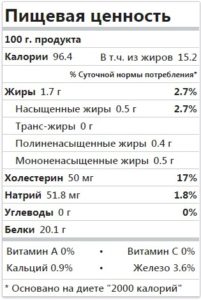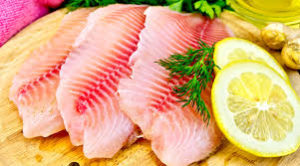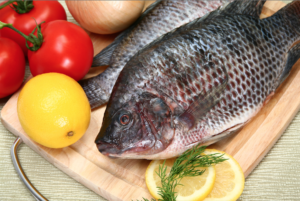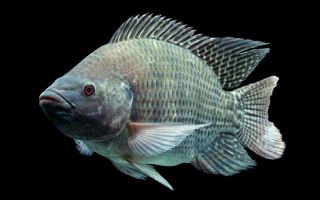Content
- 1 What is this fish and where is it found
- 2 Vitamin and mineral composition of tilapia
- 3 Nutritional information and calorie content of tilapia
- 4 Why tilapia is good for you
- 5 Is tilapia possible for pregnant and lactating women
- 6 Can tilapia be given to children
- 7 The benefits of tilapia for weight loss
- 8 Recommendations for the use of tilapia
- 9 How to cook tilapia fillets
- 10 Harm of tilapia and contraindications to use
- 11 How to choose tilapia when buying
- 12 How to store tilapia properly
- 13 Conclusion
- 14 Reviews
Among the wide range of commercial fish on the market, there are species that are ambiguous in their impact on human health. Discussions about the benefits and harms of tilapia are not only among doctors, but also among consumers. To understand whether this fish is so dangerous, it will be useful to study its chemical properties.
What is this fish and where is it found
Tilapia is a generic name for several hundred species of freshwater fish of the cichlid family. Initially, fish of this genus lived mainly in Asia Minor and Africa, but thanks to people, they became widespread in Europe, Latin America and Southeast Asia.
In appearance, different species do not differ much from each other and have a short, slightly laterally compressed body, typical of cichlids, and a large head with large eyes. Their color is most often silvery with a greenish tint. The average weight of fish ranges from 1 to 1.5 kg.

Tilapias are considered almost omnivorous, but most of their diet consists of plant foods such as phytoplankton and large algae. Organic bottom sediments play an important role in the diet of many species.
The main property of fish of the genus tilapia is their ability to adapt to abrupt changes in environmental conditions. Although they prefer tropical climates and are freshwater, tilapias are able to survive in seawater and can withstand fairly cold temperatures.
Unpretentious care and excellent taste make these fish valuable objects for industrial cultivation. They are actively bred in artificial reservoirs in China, Latin America and the United States.
Vitamin and mineral composition of tilapia
In addition to taste good, tilapia is also a source of beneficial vitamins and minerals.
It contains in large quantities:
- a wide range of B vitamins;
- vitamins E and PP;
- phosphorus;
- magnesium;
- potassium;
- selenium.
In its composition, calcium, zinc, iron, and folic acid are also less concentrated.
Nutritional information and calorie content of tilapia
Fish fillet is rich in protein, and there are practically no carbohydrates and fats. This makes the product low in calories: 100 gr. contains only 96 kcal.
In addition, fish contains omega-3 and Omega-6 acids necessary to maintain human immunity. The benefits of tilapia (or telapia) and its nutritional value are shown in the photo.

Why tilapia is good for you
Despite rumors about the dangers of tilapia, it is difficult to ignore its benefits for the human body. Nutritionists recommend eating this fish fillet to everyone, especially children, as well as pregnant and lactating women.
For adult men and women
The beneficial properties of tilapia for the adult population lie in the fact that its fillet contains half the daily value of protein, which is a building material for cells and is involved in all processes of the human body. Protein is especially important for people who are actively involved in sports, as it actively participates in the formation of muscle mass.
Vitamin E, which is part of the fish, provides elasticity of blood vessels and elasticity of the skin, which eliminates the risk of thrombosis and prolongs youth.
For the elderly
Tilapia is no less useful for elderly people. The magnesium and Omega-3 acids in fish regulate blood cholesterol levels, normalize blood pressure, reduce the risk of heart and joint diseases, maintain healthy vision, and inhibit inflammatory processes in the body. Phosphorus and potassium, in turn, provide bone strength and reduce the likelihood of developing dementia and Alzheimer's disease.

Is tilapia possible for pregnant and lactating women
Tilapia is one of the few fish species that can be safely consumed by pregnant and lactating women. Like salmon, it does not contain mercury, the excess of which has a harmful effect on the child, and the presence of vitamins and minerals in its composition helps to maintain the mother's immunity. Fish also contains healthy omega-3 fatty acids, which are essential for the healthy development of the fetal nervous system during pregnancy.
Can tilapia be given to children
Since tilapia has a tender, almost boneless fillet that boils well when cooked, it is quite suitable for baby food. As a rule, they begin to accustom a child to such food at 7 - 8 months, provided that the child is artificially fed. Breastfed babies do not need early complementary foods.
The ideal option for complementary foods is fish puree. When you first feed with fish, you should limit yourself to 1 tsp. for a meal. The next serving should be given no earlier than 24 hours later. During this time, it will become clear if the child has allergic reactions to tilapia. If, after the time has elapsed, no such reactions are detected, you can gradually increase the dosage to 50 g per dose.
Tilapia is good for children of all ages as it contains phosphorus, which helps calcium absorption and plays an important role in bone formation.
The benefits of tilapia for weight loss
Due to its low calorie content, tilapia has gained popularity among weight watchers. Fillet of this fish contains little fat, and therefore is considered a dietary product. At the same time, it is very nutritious due to the large amount of proteins, therefore it effectively helps to fight hunger.
Recommendations for the use of tilapia
Although tilapia fillet has many beneficial properties, many people are afraid to eat it. Since tilapia is an omnivorous fish, it is believed that it feeds on harmful human waste, as a result of which it accumulates toxins in its body. However, this is a delusion. All hazardous substances, if any, are retained in the fish liver, which, like the human liver, performs a protective function and neutralizes the effect of poisons. Therefore, before use, tilapia should be gutted and rinsed thoroughly. It will also reduce the risk of contamination with harmful bacteria that may be in fish.
How to cook tilapia fillets
There are many recipes for tilapia fillets. It can be stuffed, steamed, boiled, baked in foil, smoked, and in combination with drier fish, it becomes an excellent filling for pies. But the most popular and quickest ways to make tilapia are to bake or fry.
Oven-baked tilapia
To prepare 4 servings of the dish you will need:
- peeled fish fillets - 4 pcs.;
- medium-sized lemon - 1 pc.;
- mayonnaise - 4 tbsp. l .;
- any greens - 2 tbsp. l .;
- horseradish - 2 tsp;
- garlic spice - 1 tsp;
- salt and pepper to taste.

- Cover the baking sheet with foil and spread the fillets on it without adding oil. Sprinkle with salt, pepper and garlic spice and bake for 20 minutes at 200C °.
- Peel the lemon, grind the zest in a blender.
- Horseradish, mayonnaise and finely chopped herbs are mixed for the sauce, add 1 tsp to the mixture. lemon zest.
- The finished fillet is sprinkled with lemon juice and served with sauce as an independent dish or with a garnish of vegetables, pasta or rice.
Tilapia in batter
For 4 servings you need:
- tilapia fillet 8 pcs .;
- flour 300 g;
- chicken egg 2 pcs.;
- vegetable oil 2 tbsp. l .;
- salt, pepper and herbs to taste.

- The washed fillet is cut into pieces.
- Beat eggs thoroughly with a fork or blender until smooth.
- The flour is mixed with salt and pepper.
- Fillet pieces are first rolled in flour, and then in an egg, then put in a frying pan with heated vegetable oil.
- Fry the fish on both sides for 7 - 8 minutes until golden brown.
- The finished fillet is spread on a paper towel to remove excess oil. Served hot with garnish.
Harm of tilapia and contraindications to use
The main disadvantages of tilapia include the wrong combination of Omega-3 and Omega-6 fatty acids.
Recent studies by American nutritionists have shown that the level of omega-6 acid in tilapia fillets can exceed the level of omega-3 by more than 4 times.
By itself, Omega-6 has the beneficial properties of lowering blood cholesterol levels. However, it also has a negative reputation as an inflammation-causing fatty acid, while Omega-3s have proven to be anti-inflammatory.
However, tilapia is not as severe as it might seem. The content of Omega-6 in it is much less than the critical indicator. Nevertheless, you should observe the measure and eat this fish no more than 2 - 3 times a week.
Also, do not abuse tilapia for people suffering from:
- bronchial asthma;
- allergies;
- individual intolerance to the product;
- diseases of the cardiovascular system;
- arthritis and other joint diseases.
How to choose tilapia when buying

To get the most useful product, you should pay attention to the appearance of tilapia.
- In an uncut carcass, the eyes should be clear and shiny. If the eyes are cloudy, chances are high that the fish is stale.
- Preference should be given to carcasses with pale, intact scales and long fins, which indicate that the fish was raised on natural feed.
- Fresh tilapia has a faint river flavor. If the product smells like medication, the fish has most likely been chemically treated for better storage.
- When buying fillets, you should choose a product that has a uniform, dull color. Too rich color is an indicator of the presence of harmful food additives in fish. Natural fillets may contain bones.
- It is best to purchase chilled fillets, since tilapia loses a significant part of its beneficial properties during the freezing process.
It is very important to purchase tilapia in trusted places, since it is not always possible to determine the quality of the product by eye. This is often used by irresponsible fish farmers who breed unpretentious fish in infected or dirty waters, feeding them with antibiotics to accelerate growth.Fillet of tilapia grown in this way will do more harm to the body than good.
How to store tilapia properly
Tilapia does not require any specific storage conditions. Like other fish, it should be kept in a place where the temperature remains within minus values and does not exceed 0 ° C. Chilled fillets are best eaten within 1 - 3 days from the date of purchase. If the fillet has been thawed, re-freezing the product should be avoided, otherwise the development of harmful bacteria can be provoked.
Conclusion
The benefits and harms of tilapia are mainly associated with the content of omega-3 and omega-6 fatty acids in it. Consuming the product in limited quantities has significant beneficial effects. Recommendations for the selection and storage of fillets will help you purchase a quality product that can be used in the preparation of dozens of delicious dishes. Another interesting tilapia recipe can be seen in the following video:

